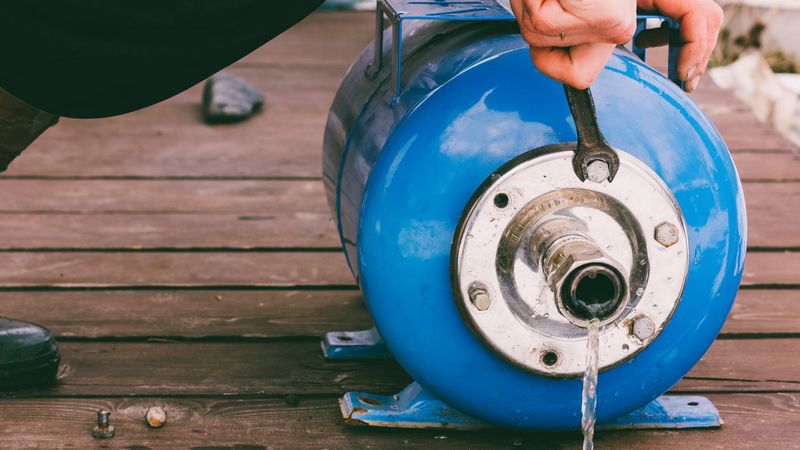
Water Heater Expansion Tank: Do You Really Need It?
If you are a homeowner, you may have heard about the importance of having a water heater expansion tank. But what exactly is it and do you really need one?
A water heater expansion tank is a small tank that is connected to your water heater. Its main purpose is to absorb excess pressure that builds up inside the tank as the water heats up and expands. Without an expansion tank, the pressure can cause damage to your water heater, pipes, and even potentially lead to leaks or ruptures.
So, how do you know if you need an expansion tank for your water heater? It depends on a few factors. One of the main factors is the type of water heater you have. If you have a closed plumbing system, meaning there is a check valve or pressure regulating valve between the water heater and the main water supply, then an expansion tank is typically required by code.
Additionally, if your water heater is located in a basement or other area where leaks or ruptures could cause significant damage, it is highly recommended to have an expansion tank installed. The cost of an expansion tank is relatively low compared to the potential cost of repairs if a leak or rupture were to occur.
What is a Water Heater Expansion Tank?
A water heater expansion tank is an additional device that is installed in the plumbing system of a water heater. It is designed to provide extra space for the water to expand when it is heated, thereby preventing the pressure in the system from becoming too high.
When a water heater heats up water, the volume of the water increases. Without an expansion tank, this increase in volume can cause the pressure in the system to rise, potentially causing damage to the water heater or other plumbing components.
An expansion tank water heater allows for this increased volume of water to be safely accommodated. It is typically installed on the cold water supply line near the water heater. The tank is divided into two chambers, separated by a flexible diaphragm. One chamber is filled with air, while the other is connected to the plumbing system.
When the water in the system expands, it is able to flow into the expansion tank, compressing the air in the tank. This helps to stabilize the pressure within the system and prevents the pressure from exceeding safe levels. When the water cools down, the compressed air in the expansion tank pushes the water back into the plumbing system.
Overall, a water heater expansion tank is a crucial component of a water heating system. It helps to protect the water heater and other plumbing components from excessive pressure, extending their lifespan and preventing potential damage.
How Does a Water Heater Expansion Tank Work?
A water heater expansion tank, also known as an expansion tank for water heater, is a crucial component of a hot water system. Its main function is to alleviate the pressure that builds up inside the water heater as the water heats up and expands.
When you heat water in a closed system, such as a water heater, the water molecules begin to move faster and spread out, causing the water volume to expand. Without an expansion tank, this increased volume of water would create excess pressure inside the tank, which could lead to leaks, bursts, or other damage to the water heater or plumbing system.
The way a water heater expansion tank works is by providing a designated space for the expanding water to go. It consists of a sealed air chamber separated from the water chamber by a flexible diaphragm. As the water expands, it pushes against the diaphragm, compressing the air in the tank. This compression of air in the tank absorbs the excess pressure and prevents it from building up in the water heater or plumbing system.
The expansion tank is typically connected to the cold water supply line of the water heater. This allows it to receive water from the main supply as it expands. When the water heater is not in use and the water cools down, the pressure inside the tank decreases and the diaphragm pushes the water back into the main water supply.
In conclusion, a water heater expansion tank plays a crucial role in maintaining the proper pressure and functionality of a hot water system. It absorbs the excess pressure caused by the expansion of heated water, preventing any potential damage to the water heater or plumbing system.
It is important to note that the installation and maintenance of a water heater expansion tank should be done by a qualified professional to ensure proper functionality and safety.
Why Do You Need a Water Heater Expansion Tank?
A water heater expansion tank is an essential component of a water heating system. It helps cope with the pressure changes that occur within the system, ensuring its proper functioning and longevity.
When water heats up, it expands. Without an expansion tank, this increase in volume can put excessive strain on the water heater and the plumbing system. The pressure can cause leaks, bursts, or damage to various components.
An expansion tank water heater helps alleviate this pressure. It acts as a cushion, absorbing the excess volume of water as it expands. It prevents the pressure from reaching dangerous levels, protecting the integrity of the system.
Additionally, a water heater expansion tank helps enhance the overall efficiency of the system. By reducing the strain on the water heater, it helps lower the energy consumption and prolong the lifespan of the appliance. This can result in cost savings and fewer maintenance issues in the long run.
In some areas, building codes may require the installation of a water heater expansion tank. This is especially true in closed-loop systems or if the water pressure exceeds a certain threshold. Compliance with these regulations ensures the safety and reliability of the water heating system.
In conclusion, a water heater expansion tank is a crucial component for maintaining a well-functioning and efficient water heating system. Its installation provides numerous benefits, including pressure regulation, improved energy efficiency, and compliance with building codes. If you want to ensure the longevity and safety of your water heater, consider investing in an expansion tank.
Signs That You Need a Water Heater Expansion Tank
If you have noticed any of the following signs, it may be an indication that you need an expansion tank for your water heater:
1. Increased pressure: If you have noticed that the pressure relief valve on your water heater is constantly releasing water, it could be a sign that your water heater is operating under excessive pressure. Installing an expansion tank can help to regulate the pressure and prevent leaks.
2. Shortened lifespan of the water heater: If your water heater has been experiencing frequent repairs or has a shortened lifespan, it could be due to excessive pressure. The expansion tank helps to relieve pressure and reduce the strain on the water heater, potentially extending its lifespan.
3. Noisy operation: If you have been hearing loud banging or knocking noises coming from your water heater, it could be a sign of water hammer. Water hammer occurs when the water flow is suddenly stopped or changed direction, resulting in a shockwave that can damage the plumbing system. An expansion tank can absorb the excess pressure and reduce the occurrence of water hammer.
4. Fluctuating water temperature: If you have been experiencing inconsistent hot water temperatures, it could be a result of thermal expansion. When water is heated, it expands and can cause the pressure in the plumbing system to increase. This can lead to fluctuations in water temperature. By installing an expansion tank, the excess pressure can be absorbed and help to maintain a more consistent water temperature.
5. Leaking faucets or pipes: Excessive pressure in the plumbing system can cause faucets and pipes to leak or fail. If you have been experiencing frequent leaks or pipe failures, it may be a sign that an expansion tank is needed to regulate the pressure.
Overall, if you have been experiencing any of these signs, it is recommended to consider installing an expansion tank for your water heater. It can help to regulate pressure, reduce strain on the water heater, prevent damage to the plumbing system, and extend the lifespan of your water heater.
Choosing the Right Water Heater Expansion Tank
When it comes to selecting an expansion tank for your water heater, there are a few key factors to consider. First and foremost, you need to ensure that the tank is compatible with your specific water heater model. Different water heaters have different requirements, so be sure to check the manufacturer’s guidelines.
Size is another important consideration. You want to choose an expansion tank that has enough capacity to handle the volume of water in your system. If the tank is too small, it won’t be able to effectively absorb the expanded water, which can lead to pressure buildup and potential damage to your water heater or plumbing system.
Additionally, consider the type of expansion tank you want. There are two main types: diaphragm tanks and bladder tanks. Diaphragm tanks have a flexible rubber diaphragm that separates the air and water chambers, while bladder tanks have a bladder that does the same. Both types can effectively accommodate the expansion of the water, but they have slightly different characteristics that may affect your decision.
It’s also worth considering the material of the expansion tank. Most tanks are made from steel, but there are also options available in copper, brass, and thermoplastic. The material you choose will depend on your specific needs and preferences.
Lastly, keep in mind that installing an expansion tank can be a complex process. If you’re not comfortable doing it yourself, it’s best to hire a professional plumber who has experience with expansion tanks and water heater systems. They will ensure that the tank is installed correctly and functioning properly to protect your water heater and plumbing system from any potential damage caused by pressure buildup.
In conclusion, choosing the right expansion tank for your water heater is essential to ensure the safe and efficient operation of your system. By considering factors such as compatibility, size, type, and material, you can select a tank that will effectively absorb the expanded water and prevent any potential damage.
How to Install a Water Heater Expansion Tank
Installing a water heater expansion tank is a relatively simple process that can help extend the life of your water heater and prevent potential damage. Follow these steps to install a hot water expansion tank:
Step 1: Gather materials
Before you start the installation process, make sure you have all the necessary materials. You will need a water heater expansion tank, pipe fittings, Teflon tape, and a wrench.
Step 2: Determine the location
Choose a suitable location for the water heater expansion tank. It should be installed on the cold water supply line, close to the water heater. Make sure there is enough space for the tank and that it can be securely mounted.
Step 3: Shut off the water supply
Before installing the expansion tank, shut off the water supply to the water heater. You can do this by turning off the main water valve.
Step 4: Drain the water heater
With the water supply turned off, drain the water heater to relieve any pressure. Open a hot water faucet in your house to facilitate the draining process.
Step 5: Install the expansion tank
Wrap Teflon tape around the threaded ends of the pipe fittings to ensure a tight seal. Connect one end of the expansion tank to the cold water supply line and the other end to the water heater. Use a wrench to tighten the fittings securely.
Step 6: Turn on the water supply
Once the expansion tank is securely installed, turn on the water supply to the water heater. Check for any leaks around the fittings and make sure they are tightened properly.
Step 7: Test the system
After turning on the water supply, check the water heater and expansion tank for any signs of leakage. Let the water heater fill up and check that it is functioning properly.
Step 8: Adjust the pressure
If necessary, adjust the pressure in the expansion tank to match the pressure of your water heater. Most expansion tanks have a pressure valve that can be adjusted using a wrench.
Step 9: Monitor and maintain
Regularly monitor the expansion tank and water heater for any issues or signs of damage. If you notice any problems, it is important to address them promptly to prevent further damage.
By following these steps, you can easily install a water heater expansion tank and ensure the efficient and safe operation of your hot water system.
Do You Need a Professional to Install a Water Heater Expansion Tank?
If you have decided to install a water heater expansion tank, you may be wondering if it is something that you can do yourself or if you need to hire a professional. While it is possible to install a hot water expansion tank on your own, it is recommended to have a professional do the job for several reasons.
Firstly, installing a water heater expansion tank involves working with plumbing and potentially electrical connections. If you are not familiar with these systems, it can be difficult to properly install the tank and ensure that it functions correctly. A professional plumber will have the knowledge and experience to safely and effectively install the expansion tank.
Additionally, hiring a professional ensures that the installation is done in compliance with local building codes and regulations. These codes may vary depending on where you live, and failing to comply with them can result in fines or other penalties. A professional plumber will be familiar with the codes in your area and can ensure that the installation is done correctly.
Furthermore, hiring a professional saves you time and effort. Installing a water heater expansion tank can be a time-consuming process, especially if you are not experienced in plumbing work. By hiring a professional, you can avoid the hassle and potential complications of attempting the installation yourself.
In conclusion, while it is technically possible to install a water heater expansion tank on your own, it is highly recommended to hire a professional. This will ensure that the installation is done safely, correctly, and in compliance with local building codes. Hiring a professional plumber saves you time and effort while providing peace of mind knowing that the job is done right.
How Much Does a Water Heater Expansion Tank Cost?
The cost of a water heater expansion tank can vary depending on several factors, including the brand, size, and type of tank you choose. On average, you can expect to pay between $40 to $250 for a water heater expansion tank.
There are two main types of expansion tanks available for water heaters: diaphragm tanks and bladder tanks. Diaphragm tanks typically cost less, ranging from $40 to $100, while bladder tanks tend to be more expensive, ranging from $100 to $250.
In addition to the type of tank, the size also plays a role in the cost. Larger tanks typically cost more than smaller tanks. It’s important to choose a tank that is appropriately sized for your water heater to ensure proper functioning.
While the upfront cost of a water heater expansion tank may seem significant, it is a worthwhile investment to protect your water heater and plumbing system from the potential damage caused by excess pressure. It can help prolong the lifespan of your water heater and prevent costly repairs down the line.
When considering the cost of a water heater expansion tank, it’s important to also factor in the installation cost. If you are not comfortable installing the tank yourself, you may need to hire a professional plumber, which will add to the overall cost.
Overall, the cost of a water heater expansion tank is a small price to pay for the protection and peace of mind it provides. It is a necessary component for maintaining a safe and efficient water heating system. Consider your specific needs and budget when choosing the right expansion tank for your water heater.
| Diaphragm Tank | $40 – $100 |
| Bladder Tank | $100 – $250 |
Water Heater Expansion Tank Maintenance Tips
Maintaining your hot water expansion tank is essential for the proper functioning of your water heater and overall home plumbing system. Here are some tips to help you keep your expansion tank in good condition:
| Regularly check the air pressure | The expansion tank has an air bladder that requires proper pressure. Use a tire gauge to check the air pressure and ensure it is within the recommended range. |
| Inspect for leaks | Check for any visible signs of leaks or water accumulation around the expansion tank. If you notice any leaks, it is important to address them promptly to prevent further damage. |
| Flush the tank annually | To remove sediment and debris that can accumulate over time, it is recommended to flush the expansion tank at least once a year. Follow the manufacturer’s instructions for proper flushing. |
| Ensure proper tank placement | The expansion tank should be installed in the proper orientation and secured tightly to prevent any movement. Make sure it is supported adequately to avoid strain on the connections. |
| Check the temperature pressure relief valve | The valve is a safety feature that releases excess pressure from the tank. Test it regularly to ensure it is functioning correctly and replace it if necessary. |
| Professional inspection | Consider scheduling a professional inspection of your hot water expansion tank and overall plumbing system to detect any potential issues and ensure optimal performance. |
By following these maintenance tips, you can prolong the lifespan of your expansion tank and avoid costly repairs or replacements. Remember, a well-maintained expansion tank is vital for the efficient operation of your water heater and the overall functionality of your home’s plumbing system.
Common Problems with Water Heater Expansion Tanks
As with any plumbing system component, expansion tanks for water heaters can experience issues that require attention. Here are a few common problems that can occur:
1. Water Leaks: One of the most prevalent issues with expansion tanks is water leaks. These leaks can occur due to a faulty valve, a loose connection, or a damaged tank. If you notice water pooling around the tank, it is important to address the issue promptly to prevent further damage.
2. Pressure Problems: The purpose of an expansion tank for a water heater is to relieve pressure by allowing the water to expand as it heats up. If the tank is not functioning properly, it may fail to regulate the pressure effectively, leading to issues such as high pressure in the plumbing system or frequent relief valve discharge.
3. Corrosion: Over time, expansion tanks can develop corrosion, especially if they are made of metal. Corrosion can weaken the tank and increase the risk of leaks or failure. Regular inspection and maintenance can help identify and address any corrosion issues before they escalate.
4. Improper Sizing: Choosing the right-sized expansion tank for your water heater is crucial for optimal performance. If the tank is too small, it may not provide sufficient room for water expansion, leading to increased pressure in the system. On the other hand, an oversized tank can be unnecessary and occupy excessive space. It is essential to consult a professional to determine the appropriate size based on your specific water heating system.
5. Lack of Maintenance: Like any other system component, expansion tanks need regular maintenance to ensure their longevity and proper functioning. Neglecting maintenance can result in a variety of issues, including reduced efficiency, increased wear and tear, and performance problems. Routine maintenance, such as checking the tank pressure, inspecting for leaks, and flushing out sediment buildup, can help prevent potential problems.
In conclusion, while expansion tanks are important for maintaining the performance and safety of your water heater system, they can experience various issues. Regular inspection, maintenance, and timely repairs can help mitigate these problems and ensure the long-lasting functionality of your expansion tank water heater.
Is a Water Heater Expansion Tank Required by Code?
Yes, in many cases, a water heater expansion tank is required by building codes. Building codes are regulations set by local authorities to ensure the safety and proper functioning of residential and commercial buildings. These codes outline the minimum requirements for construction, plumbing, and other aspects of building design and installation.
One common requirement in many building codes is the installation of a water heater expansion tank. This is because a water heater expansion tank helps to relieve pressure that can build up in the plumbing system when the water heater is running. Without an expansion tank, the pressure can cause damage to pipes, valves, and even the water heater itself.
A hot water expansion tank works by providing a space for the expanding water to go when the water heater is in use. As water heats up, it expands and takes up more space. The expansion tank acts as a safety valve, absorbing the increased volume and preventing pressure buildup in the plumbing system. When hot water is used and the water temperature returns to normal, the expanded water in the tank is slowly released back into the plumbing system.
While not all jurisdictions require the installation of a water heater expansion tank, it is generally a good idea to have one. Even if it is not required by code, it can help prolong the life of your water heater and prevent potential pressure-related problems in your plumbing system. If you are unsure whether an expansion tank is required in your area, it is best to consult with a licensed plumber or check your local building codes.
In summary, a water heater expansion tank is often required by building codes to prevent pressure buildup in the plumbing system. While not always mandatory, it is a good investment to ensure the longevity of your water heater and the overall safety and performance of your plumbing system.
FAQ:
Why should I install a water heater expansion tank?
An expansion tank helps to reduce the pressure build-up in your water heater system, which can extend the lifespan of your water heater and prevent damage to pipes and fixtures.
Does every water heater system require an expansion tank?
No, not every water heater system requires an expansion tank. It depends on the type of water heater you have and the water pressure in your home. It is best to consult a professional to determine if you need one.
What happens if I don’t install an expansion tank?
If you don’t install an expansion tank, the pressure inside your water heater system can increase, leading to leaks, bursts, or damage to the water heater itself. It can also cause fluctuations in water pressure throughout your home.
Can I install an expansion tank myself?
While it is possible to install an expansion tank yourself, it is recommended to hire a professional plumber. They have the expertise and tools to ensure proper installation and can help you select the right size of the expansion tank for your water heater system.
How do I choose the right size of expansion tank for my water heater?
The size of the expansion tank you need depends on the size of your water heater and the water pressure in your home. A professional plumber can help you determine the correct size based on your specific requirements.




